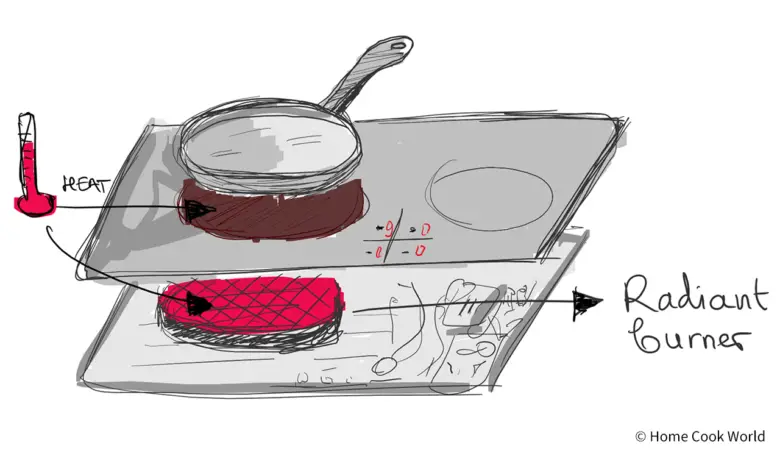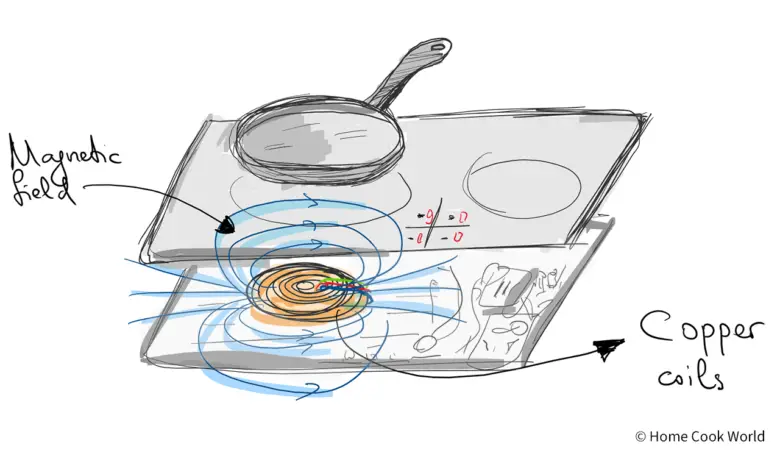Whether you’re equipping the kitchen in your new home or are about to remodel your existing place, one thing’s for sure. For those of us who cook every day, the stove/cooktop is probably one of the most important appliances in the entire house.
I’ve used almost every kind of stove you could possibly think of. My great grandmother taught me how to cook on her wood stove when I could hardly see over it. In my college days, I threw parties and cooked for friends on the stained electric coil and old gas stoves in the apartments I rented.
I dropped out of college in my junior year to start my own business. Luckily for me, it worked out pretty well, and I made enough money to graduate to a glass-ceramic cooktop. In fact, I kept cooking on one for almost a decade. Finally, about one year ago, I upgraded to induction.
In this post, I’m going to tell you all about the similarities and differences between ceramic and induction cooktops—and give you my honest take on which is better and in which case.
So, glass-ceramic cooktops (for the sake of brevity, from this moment on I’ll call them “ceramic cooktops”) and induction cooktops… How are they similar, and what makes them different?
Both ceramic and induction cooktops have a surface made of glass-ceramic. Glass-ceramic is a material that looks and feels like glass, but is much harder to break and capable of withstanding extreme heat of up to 1200°F (649°C).
Most appliance makers claim that the best cookware for flat cooktops are stainless steel pans and pots. Cook with cast iron and ceramic cookware carefully, without moving it around too much on the surface. Its rough and porous surface can easily scratch your cooktop.
Do I wish someone had told me that before I bought my first one! It took me less than a few weeks of cooking with a cast iron skillet to scratch the surface, as if I had hired a full-time cat for the job.
Compared to electric coil and gas stoves, ceramic and induction cooktops are the easiest to clean and care for. There are no coils, grates, or burners for food to fall into and grease to burn on.
To clean your flat cooktop, allow it to cool down completely, then soak a paper towel or lint-free cloth in soapy water or rubbing alcohol and wipe down the surface with it. Use a cooktop cleaning kit every 2-3 months to remove stubborn grease stains and burnt-on liquids.
The similarities between ceramic and induction cooktops end here.
When you see the details of how they work, you’ll notice that they’re nothing alike. The ways in which they bring your pans and pots up to heat are completely different.
Ceramic cooktops have electric burners that radiate heat under the surface, which heats up your pans and pots. Induction cooktops have copper coils that pass on electric current to your cookware, turning the cookware itself into the source of heat.
Ceramic Cooktops

A ceramic cooktop is sleeker looking and more efficient than an electric coil cooktop. On average, ceramic cooktops consume 12% less electricity than their coil counterparts. It’s powered by a set of radiant burners under the glass-ceramic surface.
When you place your frying pan on a ceramic cooktop and turn up the heat, the radiant burner under the surface heats up. In 15-30 seconds it gets scorching hot. That hotness gets transferred to your pan and brings it up to the heat you need for cooking food in it.
The scientific term for this is “thermal conduction,” and it comes from the field of physics. The term describes the exchange of heat that happens between two objects in contact with each other, when the temperature of one of them suddenly changes.
Even if you take the pan off the heat, the burner will keep working and the surface will stay dangerous to touch. And this is arguably the biggest deal breaker for future parents and households with babies or young children. Ceramic cooktops are not safe for kids.
In fact, I got hooked on induction cooktops from a friend who has a young daughter. He bought a new house and bought one for his kitchen a few years ago. Entering into the house one day, he saw her playing with the cooktop.
To my friend’s horror, his daughter had managed to turn the cooktop on to the highest heat and kept putting her hands on it. Happily, induction cooktops don’t heat up at all because that’s not how they work. Since there was no magnetic cookware on it, the situation gave him a terrible fright—but his child came out completely unharmed.
That wouldn’t have been the case had he equipped his kitchen with a different type of cooktop.
Pros of a glass-ceramic cooktop
- Stylish, affordable, and energy efficient
- Works with most types of cookware (see below)
- Easier to clean compared to gas and electric coil cooktops
- Provides a counter surface whenever they’re not turned on or cooling down
Cons of a glass-ceramic cooktop
- Food particles, splashes of liquid, and grease easily burn on the hot surface
- Easy to scratch with cast iron, ceramic, and glass cookware
- Aluminum and copper-bottom pans will leave marks
- Danger of burns when in contact with skin
Buy one if
You want a modern and stylish cooktop in the $150-300 to $300-$450 price range, and you’re not looking for any of the pros that only induction cooktops have to offer.
Induction Cooktops

Search for how induction cooktops work and, by the time you’re done reading most of the posts out there, you’ll most probably end up more confused than when you started.
In the next few paragraphs or so, I’m going to try to change that with a no-bs introduction to induction cooking. Keep me accountable in the comments in case I don’t achieve that.
So, how does induction cooking work?
In its simplest form, an induction cooktop is an electromagnet that you cook on. This is the reason why only cookware that contains iron will work with it.
Cast iron, enameled cast iron, carbon steel, and most stainless steel frying pans and pots will generally work with induction cooktops.
Aluminum, ceramic, copper, and non-stick usually don’t—unless the manufacturer has explicitly stated that the specific brand and model is induction-compatible.
Unlike its gas, metal coil, and glass-ceramic counterparts, an induction cooktop has no flame burners or heating elements under the surface. Instead, it runs electricity through coiled copper wires under each of its control zones, heating the cookware placed on them through electromagnetic induction.
To understand how induction cooktops work, you need to understand how electromagnetic induction works.
When you put a frying pan or pot on your induction cooktop and turn the heat up, it runs electricity through the copper coil under its surface. This generates an electromagnetic field above the control zone.
The resulting electromagnetic field consists of electric and magnetic waves that continuously oscillate with respect to each other. This makes the iron molecules in your cookware start to vibrate intensely, typically tens of thousands of times per second.
This intense vibration generates heat, which heats up your cookware almost instantly. That heat comes directly from inside your frying pan or pot—the cooktop is simply the electromagnet that triggers it.
The first time I used my induction cooktop, I was caught by surprise by the humming noise it made. As I normally do, I opened my laptop and did some research.
The humming noise, it turned out, was completely normal for this type of technology. I guess it emits energy that’s so concentrated, it makes the kind of noise you hear inside an old airplane that’s almost reached flight altitude.
There are two sides to the same coin—and what’s safe for children may not necessarily be safe for the elderly.
If you or someone else in your household has a pacemaker, don’t equip your kitchen with an induction cooktop. The strong electromagnetic field generated by the cooktop can interfere with the inner workings of the cardiac device.
This is the same reason why some home cooks stay away from induction cooktops in general, even if they’re perfectly healthy. Though electromagnetic fields are all around us in the form of light, thunder, radio waves, Wi-Fi connectivity, and cellular phone networks, not everyone’s that keen on having yet another source of them in their home.
The jury’s out on the effects of electromagnetic fields on human health as a whole, so whether or not you prefer the technology that powers induction cooktops is a deeply personal choice that everyone should make for themselves.
Pros of an induction cooktop:
- Heats up your pans and pots almost instantly
- Gives you the most precise control over cooking temperature
- Highly efficient; uses less energy than its counterparts
- Safest cooktop for families with babies and children
Cons of an induction cooktop:
- Compatible only with ferromagnetic cookware (containing enough iron)
- Noisy; often makes loud pulsing, buzzing, humming, or hissing sounds
- The electromagnetic field can interfere with other devices near it
Buy one if
You want a first-class cooktop that brings your pans and pots up to heat fast, gives you optimal control over the cooking temperature, and is safer to use than gas or electric alternatives. Induction cooktops typically sell for $750-$1,000, but higher-end makes and models can retail for as much as $3,000-$4,000.
What to Read Next
By a wide consensus, cooktop makers agree that the best cookware for induction is stainless steel. And, if you live in the US or Canada, no other company makes stainless steel pans and pots as good as All-Clad’s.
When I switched from glass-ceramic to induction, I also changed from a cast iron skillet to a stainless steel frying pan. If you’re wondering whether or not to do the same, check out what you can cook with stainless steel.

